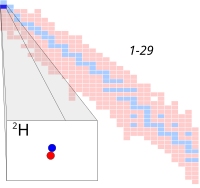
Photo from wikipedia
Blood levels of the vitamin D3 (D3) metabolites 25-hydroxyvitamin D3 (25(OH)D3), 24R,25-dihydroxyvitamin D3, and 1α,25-dihydroxyvitamin D3 (1,25(OH)2D3) are recognized indicators for the diagnosis of bone metabolism-related diseases, D3 deficiency-related diseases,… Click to show full abstract
Blood levels of the vitamin D3 (D3) metabolites 25-hydroxyvitamin D3 (25(OH)D3), 24R,25-dihydroxyvitamin D3, and 1α,25-dihydroxyvitamin D3 (1,25(OH)2D3) are recognized indicators for the diagnosis of bone metabolism-related diseases, D3 deficiency-related diseases, and hypercalcemia, and are generally measured by liquid-chromatography tandem mass spectrometry (LC-MS/MS) using an isotope dilution method. However, other D3 metabolites, such as 20-hydroxyvitamin D3 and lactone D3, also show interesting biological activities and stable isotope-labeled derivatives are required for LC-MS/MS analysis of their concentrations in serum. Here, we describe a versatile synthesis of deuterium-labeled D3 metabolites using A-ring synthons containing three deuterium atoms. Deuterium-labeled 25(OH)D3 (2), 25(OH)D3-23,26-lactone (6), and 1,25(OH)2D3-23,26-lactone (7) were synthesized, and successfully applied as internal standards for the measurement of these compounds in pooled human serum. This is the first quantification of 1,25(OH)2D3-23,26-lactone (7) in human serum.
Journal Title: Molecules
Year Published: 2022
Link to full text (if available)
Share on Social Media: Sign Up to like & get
recommendations!